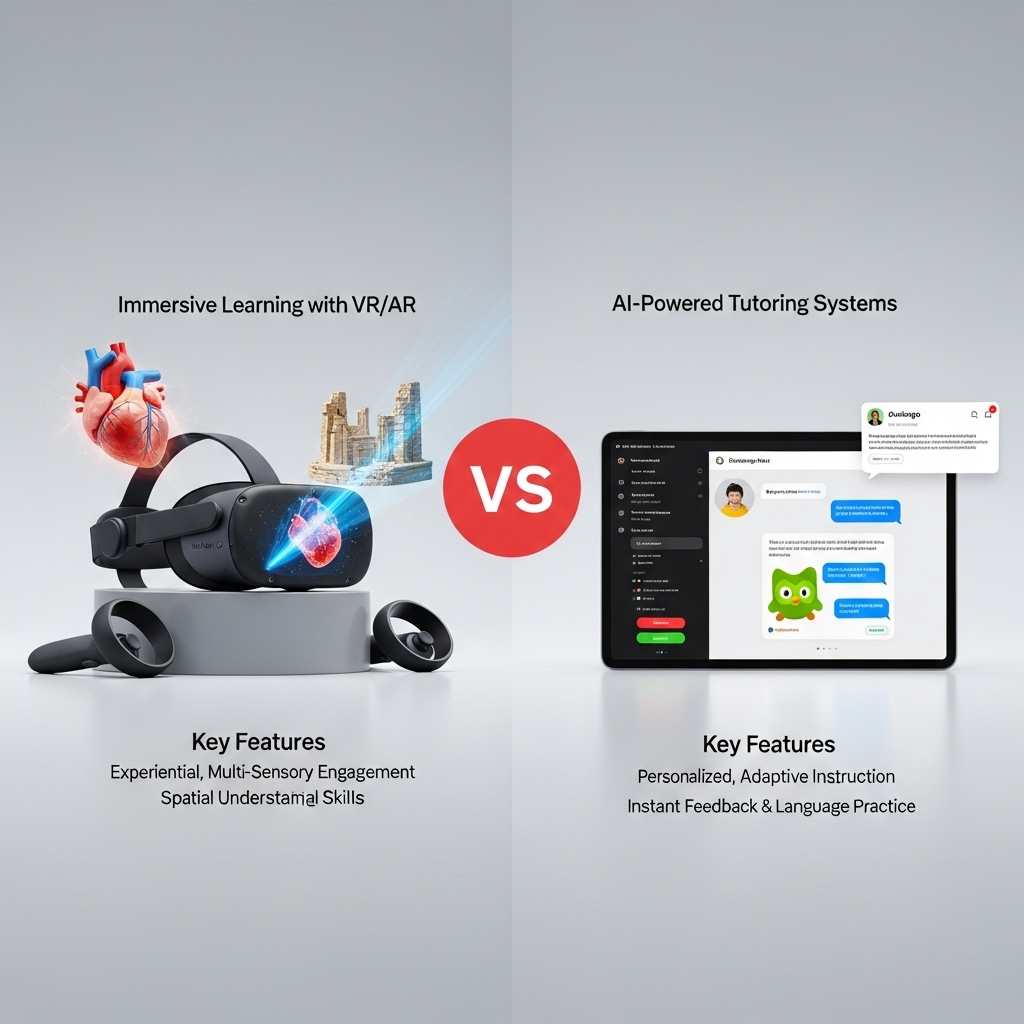Educational approaches: Immersive Learning with VR/AR (e.g., Meta Quest Education) vs. AI-Powered Tutoring Systems (e.g., Duolingo Max)
Quick Verdict
Both offer unique benefits for education; VR/AR excels in immersion, while AI tutoring provides personalized and accessible learning.
- VR/AR provides immersive learning experiences but requires teacher training.
- AI-powered tutoring offers personalized content and accessibility with minimal learning curve.
- VR/AR has higher upfront hardware costs, while AI tutoring has subscription fees.

Key features – Side-by-Side
| Attribute | Immersive Learning with VR/AR (e.g., Meta Quest Education) | AI-Powered Tutoring Systems (e.g., Duolingo Max) |
|---|---|---|
| Immersion Level | VR/AR environments create a sense of presence and immersion. | Engaging, interactive learning environments through VR/AR. Immersive VR tends to have a greater impact on engagement. |
| Content Customization | VR/AR enables educators to tailor educational experiences to individual student needs and learning styles. | AI-powered systems analyze learner data to deliver personalized content, recommendations, and guidance. |
| Learning Curve | Training is needed to help teachers implement VR/AR technology effectively in classrooms. | Generally no learning curve to start using AI-powered teaching assistant tools. |
| Accessibility | VR/AR technologies can improve visibility for those with visual impairments. | Offers support anytime, anywhere, making education more accessible. |
| Price | Meta Quest 3: $630, Quest 3S: $400 (128GB) or $500 (256GB). Option to unlock 'lifetime' access for an additional $100 per headset. | Duolingo Max: Individual annual subscription (US) around $168, family plan about $200 per year. Monthly plans are also available. |
| Scalability | VR environments can be replicated for numerous learners, and remote collaboration is simplified. | AI-powered tutoring systems can accommodate large numbers of learners and courses, making them suitable for organizations of all sizes. |
Overall Comparison
Immersion: VR/AR wins; Customization: AI wins; Price: AI is cheaper; Scalability: Both scalable
Pros and Cons
Immersive Learning with VR/AR (e.g., Meta Quest Education)
Pros:
- Creates a sense of presence and immersion
- Enables tailored educational experiences
- Improves visibility for those with visual impairments
- Aids communication for individuals with auditory impairments
- Offers immersive, experiential learning environments aligned with curriculum standards
- Positively impacts student motivation, memory retention, and overall engagement
- VR environments can be replicated for numerous learners
- Remote collaboration is simplified
- AI-enabled adaptive learning platforms track student progress and adjust content and delivery in real-time
Cons:
- Training is needed to help teachers implement VR/AR technology effectively
- Schools must set up student accounts to protect student data
AI-Powered Tutoring Systems (e.g., Duolingo Max)
Pros:
- Engaging and interactive learning environments through VR/AR
- Personalized content and guidance based on learner data
- Support anytime, anywhere, increasing accessibility
- Cost and time-efficient compared to traditional methods
- Instant answers to student queries via AI tutors and chatbots
- Comprehensive learner data collection and analysis
- Interactive learning experiences with multimedia and gamification
- Scalable to accommodate large numbers of learners
- VR/AR positively impacts student motivation, memory retention, and overall engagement in the learning process.
Cons:
- Costs vary widely for VR/AR implementation, including hardware, software, content creation, and training.
- Need for measures to protect student data and ensure privacy.
- Hardware requirements for VR can be demanding.
User Experiences and Feedback
Immersive Learning with VR/AR (e.g., Meta Quest Education)
What Users Love
- VR/AR environments foster a sense of presence and immersion.
- VR/AR learners learn faster and maintain more focus.
- Educators can leverage VR/AR to tailor educational experiences to individual student needs and learning styles.
Common Complaints
- No major complaints reported.
Value Perception
- No value feedback reported.
AI-Powered Tutoring Systems (e.g., Duolingo Max)
What Users Love
- VR and AR technologies enhance student engagement by creating interactive and immersive environments.
- AI-powered tutoring systems tailor educational content to each student's specific needs.
- AR and VR create a more accessible environment for those with disabilities.
Common Complaints
- No major complaints reported.
Value Perception
- No value feedback reported.